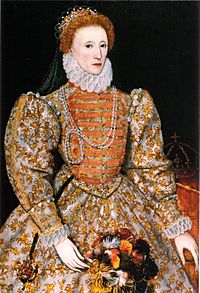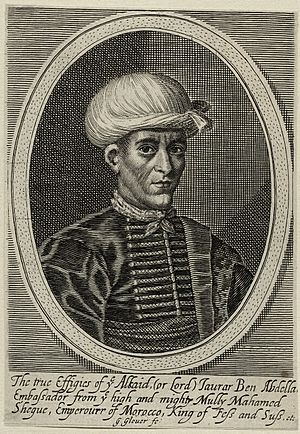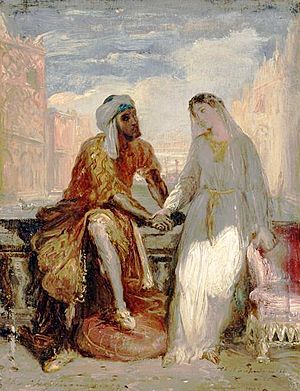Anglo-Moroccan alliance facts for kids
Right image: Moroccan ambassador to Elizabeth, Abd el-Ouahed ben Messaoud, in 1600.
The Anglo-Moroccan alliance was a special friendship between the kingdoms of England and Morocco. It started in the late 1500s and early 1600s.
Queen Elizabeth I of England and the Moroccan Sultan Ahmad al-Mansur made trade deals. They both disliked Philip II of Spain, which helped them become friends. They mostly traded weapons. They also tried to work together in military actions.
This alliance continued for a while, even after Elizabeth and Ahmad passed away.
Contents
Why England and Morocco Became Friends
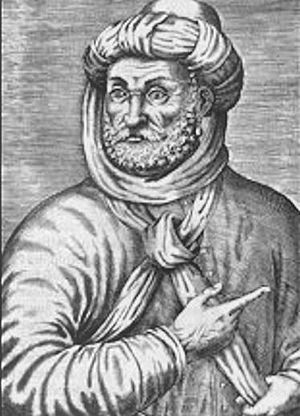
The friendship between England and Morocco grew during the 1500s. This was thanks to regular trade, especially by a family of merchants called Amphlett. Before this, countries like Spain, Portugal, and Genoa controlled most European trade with Morocco.
But in 1541, Portugal lost some important cities in Morocco, like Safi and Agadir. This made their control weaker.
English ships, like The Lion in 1551, started sailing to Morocco. Later, the English Barbary Company was set up in 1585. This helped trade grow between England and the Barbary states, especially Morocco.
Morocco often traded sugar, ostrich feathers, and saltpeter (used for gunpowder). In return, England sent fabrics and firearms. Spain and Portugal often complained about this trade.
Queen Elizabeth I and Sultan Abd al-Malik exchanged many letters. They wanted to make trade easier for English merchants. The Sultan could speak Spanish and Italian, as well as Arabic. In 1577, he wrote to the Queen in Spanish. That same year, the Queen sent Edmund Hogan as her ambassador to Morocco.
Forming the Alliance
At first, Queen Elizabeth was careful about selling weapons to Morocco. She worried what other Christian countries might say. Her ambassador, Hogan, told the Sultan this in 1577.
However, their talks soon led to a political alliance. This happened after Portugal was defeated in the Battle of Alcácer Quibir in 1578. Elizabeth I and Sultan Ahmad al-Mansur then had more diplomatic discussions.
Working Together Against Spain
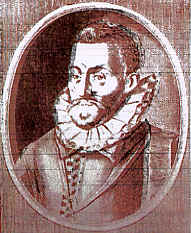
Relations became stronger when Philip II of Spain also became King of Portugal in 1580. This led to the Anglo–Spanish War starting in 1585.
In 1581, Elizabeth allowed England to send wood for ships to Morocco. In return, England got saltpeter, which was needed for gunpowder. The Barbary Company, set up in 1585, gave England a special right to trade with Morocco for 12 years.
From 1585 to 1588, Elizabeth tried to get the Sultan's help. She wanted him to support Dom António, who claimed to be the rightful king of Portugal. In 1588, Sultan Al-Mansur gave special benefits to English traders.
In her letters to Al-Mansur, Elizabeth often called their relationship "The great friendship and cooperation that exists between our Crowns." She also called herself "Your sister and relative according to the law of the Crown and the Scepter." She wrote this for 25 years.
In January 1589, Al-Mansur sent his ambassador, Marzuq Rais, to the Queen. He asked for oars, carpenters, and shipbuilders. He also wanted English ships to transport his forces. In return, he offered money and military help for a joint attack on Spain. He also asked for English military help if Morocco had a conflict with other non-Christian countries.
Elizabeth could not agree to all his requests, especially transporting Moroccan soldiers. Talks continued until Dom António died in 1595.
The English expedition to Portugal went ahead in 1589 anyway. It failed because the English fleet waited for help that never came. Only the Moroccan ambassador, Marzuq Rais, was with the expedition. He was disguised as a Portuguese nobleman on Dom António's ship.
The 1600 Embassy to England
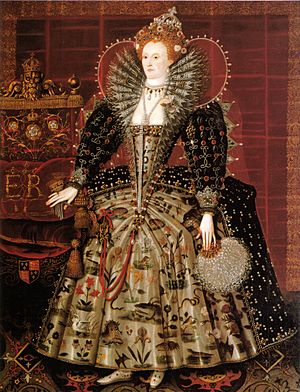
Diplomatic relations between England and Morocco continued to grow. England traded with Morocco, which was bad for Spain. England sold armor, ammunition, wood, and metal for Moroccan sugar. This happened even though the Pope had forbidden it.
In 1600, Abd el-Ouahed ben Messaoud visited England. He was a main secretary to the Moroccan ruler Mulai Ahmad al-Mansur. He came as an ambassador to Queen Elizabeth I's court.
Abd el-Ouahed ben Messaoud stayed at Elizabeth's court for six months. He was there to discuss an alliance against Spain. The Moroccan ruler wanted an English fleet to invade Spain. Elizabeth said no to this. However, she welcomed the visit and agreed to make trade deals.
Queen Elizabeth and King Ahmad kept talking about joint military plans. Elizabeth asked for money in advance for a fleet. Ahmad asked for a large ship to collect the money. Elizabeth "agreed to sell munitions supplies to Morocco." They also discussed a joint operation against the Spanish. But their talks did not lead to a final agreement. Both rulers died within two years of the embassy.
Relations Under James I and Charles I
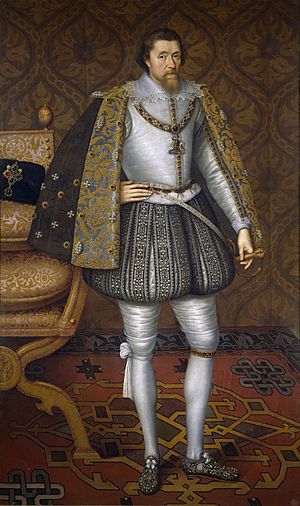
After Ahmed al-Mansur died in 1603, Morocco became less stable. Local leaders gained power, making the alliance with the Sultan less important. Also, James I became king in 1603 and made peace with Spain. This was done through the Treaty of London.
However, relations continued under James I. He sent his ambassador John Harrisson to Muley Zaydan in Morocco in 1610, 1613, and 1615. His goal was to free English prisoners in Morocco. English privateers, like Jack Ward, also continued to work with the Barbary states, including Morocco.
During the Thirty Years' War, under King Charles I, England looked for Moroccan military help. This was in Tetouan and Salé. England hoped for Moroccan help after a failed English attack on Cadíz in 1625. This attack had damaged England's reputation.
On May 10, 1627, England made a deal with a local leader named Sidi Al-Ayyashi. They wanted his help to free English prisoners. In return, England would provide supplies and weapons. England and Al-Ayyashi worked together for about 10 years. For example, they tried to free Al Ma'mura together.
In 1632, English ships and Moroccan forces worked together to capture the city of Salé. Salé was a major pirate harbor. Taking it helped calm the city and freed Christian prisoners.
On May 13, 1637, Charles I and Sidi Mohammed el-Ayachi, the leader of Salé, signed an agreement. It allowed England to supply military weapons to the Sultan.
Later Embassies of Mulay Ismail
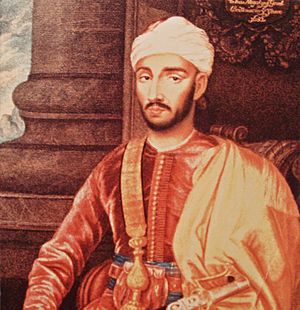
Relations continued under the Moroccan ruler Mulay Ismail. In 1682, he sent Mohammed bin Hadou as ambassador to the English court of Charles II. Mohammed stayed in England for six months. His visit was much talked about. He visited places like Oxford, Cambridge, and the Royal Society.
These visits showed how England and Morocco had changing alliances for 40 years. These changes were linked to European conflicts, trade, pirates from the Barbary Coast, and exchanging prisoners.
A key moment happened in 1720–21. English ambassadors John Windus and Commodore Hon. Charles Stewart visited Morocco. They successfully signed a diplomatic treaty with Morocco for the first time. They returned home with 296 freed British slaves.
Moroccan ambassadors were sent to England again in 1726. In 1727, a new treaty was signed by John Russel with Mulay Ismail's successor. Another treaty, the Anglo-Moroccan Accord, was signed by John Drummond-Hay in 1865.
How This Alliance Influenced Stories
These strong connections between England and Morocco likely affected English literature of that time. This includes plays by Shakespeare and The Battle of Alcazar by George Peele.
These contacts might have inspired characters like Shylock or the Prince of Morocco in The Merchant of Venice. Some even think that the Moroccan ambassador, Abd el-Ouahed ben Messaoud, inspired Shakespeare's hero Othello.
See also
 In Spanish: Alianza anglo-marroquí para niños
In Spanish: Alianza anglo-marroquí para niños
- Morocco–United Kingdom relations
- List of Ambassadors of Morocco to the United Kingdom
- Islam and Protestantism
- Islam in England


